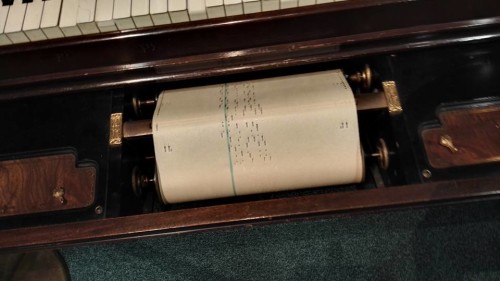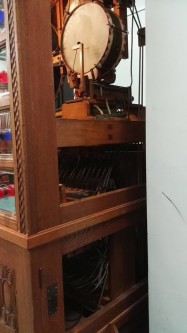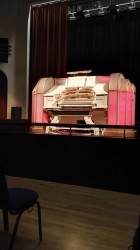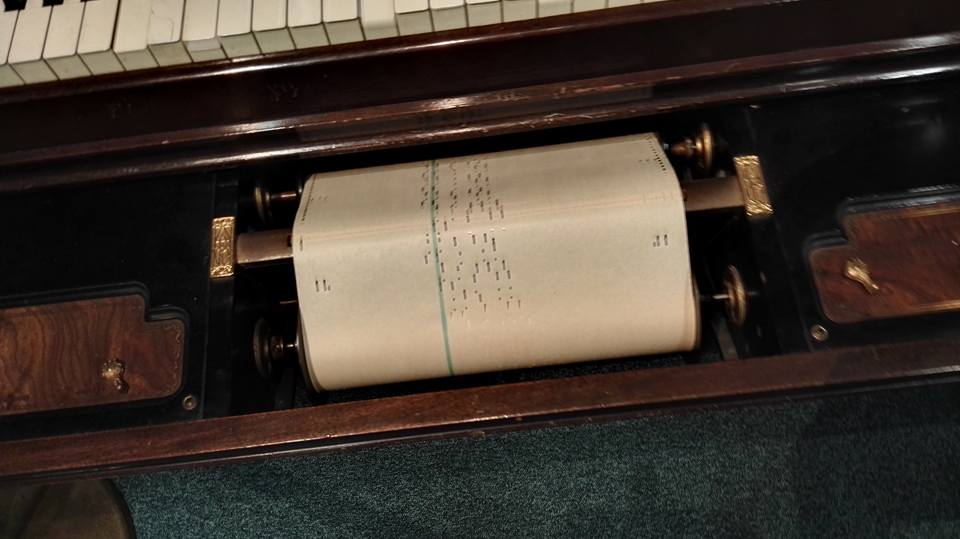The Musical Museum (MM) at Kew Bridge has to be one of the most fun places that any lover of music can visit. It is not only a romp into the depths of nostalgia – some of it unexplored -but also a detailed adventure as to how we arrived at where we are now as listeners.
The Museum’s founder, Frank Walter Holland, no longer able to contain his huge private collection of these sometimes very large instruments, transferred them to the deconsecrated St George’s Church, High Street, Brentford in 1963. But the church was damp and not good for the instruments. It was here that I first saw the collection. However, in 2007 it was transferred to its new, purpose-built museum space with its own concert hall, bar, shop and restaurant, with its new name, The Musical Museum. And just a few yards from the church, on the other side of the river.
You may remember a chilling BBC horror film in the sixties in which a ghost disturbs a household by playing a piano itself in the middle of the night. This was filmed on the 1904 violana virtuoso, then in the church, and chilling to behold, even in broad daylight. But I am getting ahead of myself.
The MM is entirely manned by knowledgeable volunteers. Tours on Tuesday, Friday, Saturday and Sunday at 11am and 3pm last about an hour. Or more if you are unlucky enough to have someone asking as many questions as me. Thanks to Steve Lewis who was gracious and witty in his answers. Like the very best experts, Steve doesn’t just give answers; he gives answers to questions you probably couldn’t have thought up.
Ctesibius (285-222BCE) was almost certainly the first inventor of mechanical music as well as the first director of the famed museum of Alexandria in Ptolemaic Egypt. In his early life he was a barber, and invented an organ which worked on water pressure, to entertain his customers. It is maybe stretching things to see this as the forerunner of the jukebox, but not such a stretch when you remember the water organs which flourished in Renaissance Italy, albeit in churches rather than barber shops.
The organ in the chapel in the almshouse complex where I live, and which operates on pumped air, was recently magnificently restored to all its glory, and was at origin the brainchild of Archbishop John Whitgift in the reign of Elizabeth I. The archbishop was a classicist (Francis Bacon among his students when he taught at Cambridge) and would have known of Ctesibius’s work.
The MM’s collection of musical boxes is vast. These flourished particularly with the development and expansion of the Swiss watch and clock industry. Sound was added to sight for telling the time. It was then rapidly realised you could have the sound without the sight. The Swiss, famed for their development of new markets, began accepting commissions, first from Europe’s nobility, but soon from a wider market.
Turning to the more recent developments of the historical spectrum, it is fascinating to see that not every new invention represented progress.
While 78rpm records give us a fair idea of how some pianists sounded, they are nothing to compare with the piano rolls of those pianists. Saint-Saëns refused to make 78s; his piano rolls have been transferred now to CD, but of course, you lose something in the transfer. The MM has some Saint-Saëns in its huge library of rolls. But it is necessary to make an appointment to listen to them.
The violana virtuoso is the player piano invented by Henry Konrad Sandell, a Swede living in Chicago in or about 1904. It was produced by Mills Novelty Company. The MM’s instrument is an improved model and a baby grand and called Chickering ampico Model B and made in the 1920s.
It was on this instrument (a baby grand) that Rachmaninoff took many days to make his registration of his C sharp minor prelude. The nuances are astonishing. As though he is playing live in the room! Much more nuanced than any of his electric recordings of the same period. To my ear Rachmaninoff had always sounded distant from the music he was playing, even when that was his own music. Not so here. This was the highlight of the visit. Connect is the word. And it is understandable how the composer painstakingly took days to do just that. Many takes were cut onto the rolls. Many repetitions led to the perfection which the composer finally accepted.

The violana virtuoso was clearly designed for public use; it is operated by inserting a coin. All the coin operated machines in the MM have had that mechanism replaced with a simple push-button starter. The MM emphasises that all restoration is undertaken with as few changes as possible, including the replacement of individual parts with materials of the same period wherever possible.
At the beginning of the nineteenth century, music machine manufacturers found themselves in competition with one another as to who could produce the best orchestrations. We have come in our own times accustomed to sound as an adjunct to vision, but here are orchestrations of huge proportions whose impression is almost more sight with sound surpassing the vision. Given their size and complexity these players were only available to the very rich. Status symbols then, among their other accomplishments. The accomplishments today have a distinct comic effect on us. Camp in effect. Until we begin to appreciate the engineering feats and imagination that brought them into being.
The 1910 German restored model in the MM plays with violin, mandolin and drums effects, with those instruments clearly visible through glass panels, the model is over two metres high, wide and deep. This particular player is coin operated, so may have been designed for an expensive hotel or other public space. 
The Keith Prowse & Co coin operated player piano with water pump was possibly one of the first pub pianos. The museum’s model is from 1920. The sound and repertory evokes another era of entertainment. One feels the pleasures of that distant audience. We have undisputed advantages in our times of acoustic-perfect concert halls and CD reproduction. But the MM is a continual reminder that we lost something too. (I have defended the pub pianist and his repertory [it was almost always a he] in another place.)
On the museum’s first floor is the concert hall in which a mighty Wurlitzer reigns supreme. This huge American-made organ has been installed on a traditional hydrologic lift to hoist it up and down in front of a cinema screen. The Wurlitzer was king in the era of the silent movies (the first thirty years of the twentieth century). Not only did it provide music to accompany the comedies and dramas but it was also fitted with stops for sound-effects: trains going through tunnels, storms, rough seas, calm seas and so forth.

Audiences looked forward to the Wurlitzer at their cinema, sometimes more than the film. Even after 1927 when films began to talk and sing, the Wurlitzer would perform before and after the movie. And sometimes at an interval in the film which cinema managements, prompted by audiences, had requested.
I am just old enough to come in at this point in the story. It is a bit of nostalgia which still makes me laugh. That pinkish, nasal sound which is part of the mechanism which produces these wonders would be brought on before and after the film, whereon hoards of schoolboys (like me) would be screeching with laughter while being shushed by our parents’ generation.
Readers of my generation may remember the broadcasts of Reginald Dixon from the Blackpool Tower Ballroom. And that institution was never even a cinema!
In fact, the MM’s Wurlitzer was built in 1929 but was then enlarged, shipped and installed in the newly-opened Regal Cinema in Kingston on Thames in 1932. Like Blackpool Tower it was also a broadcasting organ, even after it was acquired by MM in 1972 and broadcast again several times by the BBC.
The museum also acquired a Steinway grand which had been painted pink! when it was bought from a Leicester cinema. The MM restored it to its original black and linked it to their Wurlitzer, so the organist can pull a stop to make the keys play exactly what the organist is playing. You see the piano’s keys going up and down on their own just like the horror movie.
Wurlitzers played rolls as well as all the effects they could obtain with stops, including link stops with other instruments. A live orchestra doesn’t stand a chance against this competition!
Jack Buckley
On Sunday 1 July at 3pm organist, Donald McKenzie will be accompanying Laurel & Hardy short, silent movies as well as playing popular music of the Mighty Wurlitzer. Tickets: 12.50. Box Office: 0208 560 8108. Open Tuesday, Friday, Saturday, Sunday from 10.30am to 5pm. www.musicalmuseum.co.uk The Musical Museum, 399 High Street, Brentford, TW8 0DU.
Photos courtesy of Christopher Axworthy.

Dear Jack,
Sorry! Saint-Saëns, so far from refusing to make 78s, made two series of disc recordings in Paris. For the Gramophone & Typewriter Company In June1904 he recorded five solo pieces, all his own compositions, and four records accompanying the mezzo-soprano Meyriane Héglon in arias from “Ascanio” and “Samson et Dalila” and two of his songs. Then for the same company, now named His Master’s Voice, he recorded four solos in 1919 and four records accompanying the violinist Gabriel Willaume in 1923 circa. The HMV records remained in the catalogues until about 1946 but are, none the less, scarce. The G & T records are among the rarest in existence. All his records can be heard in splendid sound on the Marston records CD set 52054-2, Legendary Piano Recordings.
Many thanks Michael for setting this record straight. Where would we be without Marston records?
Jack
Hi Jack
Many years ago there was a BBCTV programme about the versatility and variety of keyboard instruments. Frank took various items from the museum. They invited Ted Heath to the piano but also his Goff Clavichord. I was there because my husband looked after it for him and of course it had to be tuned in situ.Others on the programme were Joshua Rifkin and Oscar Peterson who played (his?) a Bosendorfer with extra notes at the bottom. He was so captivated by the clavichord, he bought one and made an album on it!!! Sylvia
Many thanks for sharing this interesting experience Sylvia. I know from Chris Axworthy that Sydney Harrison and Graham Johnson were involved in early recordings from the time the Museum was in the damp church. Pulling Ted Heath out of your hat is a real coo!
Jack
I seem to remember hearing a Wurlitzer recital during the intermission of a film at a cinema in Manchester, circa 1969. I visited the collection under review probably in the late seventies with Frank Holland as the tour guide .The Jack Buckley take on this is far more interesting though! Personally I would say that the American Music Museum, formerly known as the Shrine to Music , has the best collection that I know of, but I have great memories of visiting the Adam Carse musical instrument collection housed in the Horniman Museum ,in the south east London (area). I don’t know if it still exists but if it does, perhaps it would it could form the basis of a future article by this reviewer.
Yes, Andrew, the Musical Instruments at the Horniman Museum do indeed still exist. But they are entirely of a different order. These are often valuable instruments (especially string instruments) which Horniman’s friends had left him in their wills. Unlike Frank Holland’s collection, there are few mechanical instruments, though I do remember musical boxes. I value the Horniman museum for its fabled gardens and its organic farmers’ market on Saturday morning! It’s reasonably close to where I now live. I’m not surprised when you tell us that America has the best collection. In the Wurlitzer era they were Kings of that Empire. I should have been clearer about that in my ruminations.
Fascinating Jack. Thank you. I think one of my favourite cinema organ pieces is the opening scene of that now cult film starring Vincent Price as the mad organist, “The Abominable Dr. Phibes” (1971). However, there are those more knowledgeable than I who claim the “March of the Priests” was recorded on a church organ.
I’m glad to hear that the Horniman Museum is still there – to me it was one of the better London museums but ‘off the beaten track’. I’m overdue to revisit the Music Museum formerly known as the ‘Shrine to Music’. It’s in a small college town in the middle of America (Vermillion, South Dakota) At five hours driving time from where I live that would be considered ‘reasonably close’ considering the sheer size of the country. They have pianos with the keys arranged more like a typewriter and others which rarely need tuning which were considered superior but never caught on. Wurlitzer has another legacy aside from the organs – indifferent pianos. There are a lot of them around and I see them almost daily!